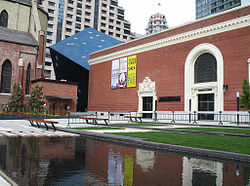- Contemporary Jewish Museum
-
Coordinates: 37°47′09″N 122°24′14″W / 37.78577°N 122.40394°W
The Contemporary Jewish Museum 
Established 1984 Location 736 Mission Street, San Francisco, California, USA Director Connie Wolf Public transit access BART and MUNI Website www.thecjm.org/ The Contemporary Jewish Museum (CJM) was founded in 1984 in San Francisco, California, with the goal of offering contemporary perspectives on Jewish culture, history, art, and ideas. In June 2008, the Museum moved to the Yerba Buena Gardens district of San Francisco’s South of Market neighborhood, into a new building designed by architect Daniel Libeskind.[1]
Contents
History
The museum began in 1984 as the Jewish Community Museum located in San Francisco’s financial district. Ten years later, the board decided to move to the Yerba Buena Gardens on Mission Street. Architect Peter Eisenman proposed a design for the new building, but the museum’s trustees and local residents rejected it.[2] In 1998, the museum hired Daniel Libeskind and construction began in 2006.[3]
The museum has no permanent collection. Instead, it curates and hosts a broad array of exhibitions, such as “In the Beginning: Artists Respond to Genesis” and "From The New Yorker to Shrek: The Art of William Steig," throughout the year.[4]
Former Whitney Museum curator Connie Wolf became the museum’s director in 1999.[5]
Architecture
Daniel Libeskind designed the 63,000 square foot (5,900 square meter) museum, which occupies and extends the 1907 Jesse Street Power Substation, originally designed by Willis Polk. Delays and budget issues forced Libeskind to alter his original design for the building, which was completed in 2008. The museum cost $47.5 million to build.[6]
Design
 Interior view of the "Yud."
Interior view of the "Yud."
The museum’s tilted, dark-blue stainless steel cube, constructed by A. Zahner Company, slices into the old substation’s brick, making visible the relationship between the new and the old. Libeskind’s design preserves the defining features of Polk’s old building, including its brick façade, trusses, and skylights. 36 diamond-shaped windows light the top floor of the metal cube, known as the Yud, which hosts sound and performance based exhibitions. The museum’s other section, a slanting rectangle known as the Chet, holds the narrow lobby, an education center, and part of an upstairs gallery.
Similar to Libeskind’s Danish Jewish Museum in Copenhagen, the Contemporary Jewish Museum incorporates text into its design. Inspired by the phrase “L’Chaim,” meaning “To Life,” Libeskind let the Hebrew letters that spell “chai” —“chet” and “yud,” inspire the form of the building. The Hebrew word pardes, meaning “orchard,” is embedded in the wall of the lobby.
The building also houses a multi-purpose event space, an auditorium, a café, and the museum store.[7]
Reaction
Critics, such as Christopher Hawthorne of the Los Angeles Times, praise Libeskind for a “careful balance of explosive and well-behaved forms” and gallery designs that abandon the architect’s characteristic slanted walls.[8] Likewise, David D’Arcy of the Wall Street Journal sees the museum as a laudable departure from Libeskind’s previous work. He finds a “lightness to this [museum] that is rare in the architect’s work” and that “relieves the surrounding district’s glass and steel tourist-mall monotony.” D’Arcy, however, bemoans the project’s budgetary restrictions, which he argues are apparent in the museum’s “architecturally clumsy” multi-purpose space.[9]
Edward Rothstein of the New York Times criticizes the museum for its dedication to “multiple perspectives and open-mindedness…without a grounding in knowledge, without history, detail, object and belief.” Without a permanent collection, the Contemporary Jewish Museum forgoes a sense of a collective Jewish past, he says.[10]
See also
- Jewish Museum Berlin
References
- ^ Contemporary Jewish Museum of San Francisco. "History and Mission". http://www.thecjm.org/index.php?option=com_content&task=view&view=article&id=3. Retrieved 2008-07-25.
- ^ D’Arcy, David (June 26, 2008), "Daniel Libeskind Opens A Jewish Museum For All", Wall Street Journal: D7, http://online.wsj.com/public/article/SB121443540348605145.html?mod=2_1578_topbox
- ^ Studio Daniel Libeskind. "Contemporary Jewish Museum". http://www.daniel-libeskind.com/projects/show-all/contemporary-jewish-museum/. Retrieved 2008-07-28.
- ^ D’Arcy, David (June 26, 2008), "Daniel Libeskind Opens A Jewish Museum For All", Wall Street Journal: D7, http://online.wsj.com/public/article/SB121443540348605145.html?mod=2_1578_topbox
- ^ Hawthorne, Christopher (June 4, 2008), "Slash and Yearn", Los Angeles Times: E1, E14
- ^ Hawthorne, Christopher (June 4, 2008), "Slash and Yearn", Los Angeles Times: E1, E14
- ^ Studio Daniel Libeskind. "Contemporary Jewish Museum". http://www.daniel-libeskind.com/projects/show-all/contemporary-jewish-museum/. Retrieved 2008-07-28.
- ^ Hawthorne, Christopher (June 4, 2008), "Slash and Yearn", Los Angeles Times: E1, E14
- ^ D’Arcy, David (June 26, 2008), "Daniel Libeskind Opens A Jewish Museum For All", Wall Street Journal: D7, http://online.wsj.com/public/article/SB121443540348605145.html?mod=2_1578_topbox
- ^ Rothstein, Edward (June 9, 2008), "Museum’s Vision: West Coast Paradise", New York Times: E1, E6, http://www.nytimes.com/2008/06/09/arts/design/09jewi.html?_r=1&scp=1&sq=&st=cse&oref=slogin
External links
- Official site
- San Francisco Chronicle article about new facility
- Los Angeles Times article about the groundbreaking
Museums Asian Art Museum · Berkeley Art Museum and Pacific Film Archive · Cantor Center for Visual Arts · Cartoon Art Museum · Palace of the Legion of Honor · Contemporary Jewish Museum · de Young Museum · Mexican Museum · Mills College Art Museum · Museo ItaloAmericano · Museum of Craft and Folk Art · Museum of the African Diaspora · Oakland Museum · Randall Museum · San Jose Museum of Art · SFMOMA · Wattis Institute for Contemporary Arts · Yerba Buena Center for the Arts
Artist-in-residence programs Public and site-specific Defunct Categories:- Museums in San Francisco, California
- Jewish museums in California
- Museums established in 1984
- Daniel Libeskind buildings
- Deconstructivism
- Postmodern architecture in California
- 1984 establishments in the United States
Wikimedia Foundation. 2010.


